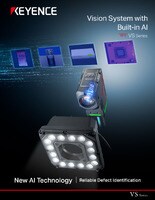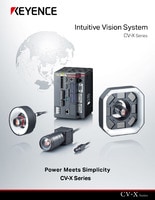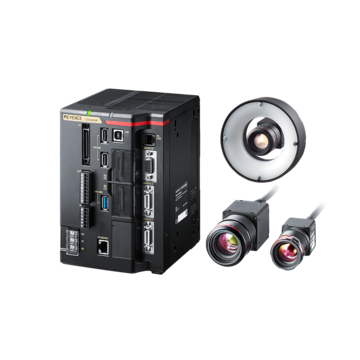Vision Systems
- Vision System with Built-in AI VS series
- Intuitive Vision System CV-X series
- Customizable Vision System XG-X series
- GigE camera and lighting for PC-based machine vision VJ series
- Inline 3D Inspection 3D Vision series
- 3D Vision-Guided Robotics 3D VGR series
- Line Scan Technology Line Scan series
- 2D Vision-Guided Robotics 2D VGR series
- LED Lighting CA-D series
- Lenses (for Machine Vision) CA-L series
- Machine Vision System Database VisionDatabase series
- Automotive
- Automation Equipment/Machine Building
- Electric Vehicles
- Medical Device Manufacturing
- Food/Beverage Packaging
- Semiconductor/Manufacturing Electronics
- Vision-Guided Robotics
- Solar
- Logistics
- Commodities
- Paper Manufacturing
- Machine Tools
- Electronic Device
- Printing
- Mining/Metals
- Fabric/Textile
- Tobacco
- Marine
- Aerospace
Missing Ball-Bearing Inspection for the Automotive Industry
KEYENCE provides innovative vision solutions that deliver accurate measurement and inspection results. Inspection standards in the assembly of machines and systems that use bearings rely heavily on the quality of the inspection system used.
Our vision technologies boast of precise and accurate inspection results of critical components like bearing balls irrespective of size or type. Discover how KEYENCE vision systems can be utilized for missing ball-bearing inspection in the automotive industry.
We’re here to provide you with more details.
Reach out today!

Challenges in Inspecting for Missing Ball-Bearings
Visual Similarity
The color and texture of ball bearings can match those of the surroundings or other components in a system, making it difficult for a human inspector or vision system to detect missing components.
Size
Ball bearings are relatively small compared to other components in a machine or system. Coupled with their tiny nature is the concealed placement in many systems, making it easy to miss or overlook their absence.
Complex Assemblies
Ball bearings are part of the complex assembly of locomotive axles, engine shafts, chassis, or other system parts. Embedded bearings in complex systems often require specialized inspection solutions.
Unclear Indicators
It is difficult to know when ball bearings are missing because there are no clear signs or indicators of their absence. The lack of well-defined, visible damage or noise in a system can pose an inspection challenge.
Discover more about this product.
Click here to book your demo.

Vision Systems for Ball-Bearing Visual Inspection
KEYENCE offers vision products for inspecting missing ball bearings in production and manufacturing settings. Our 2D and 3D vision systems for automotive manufacturing help detect defects and irregularities such as cracks, rust, dent, contamination on ball bearings, and missing ones.
Our solutions help verify the structural integrity of bearing balls in coupled systems and machines before final assembly. We take pride in the accuracy with which our vision systems can accurately identify incorrect or missing ball bearings regardless of their type, size, and inspection surface.
Vision System With Built-In AI
KEYENCE VS Series has built-in AI tools for accurate image analysis and processing. The KEYENCE ZoomTrax feature incorporates advanced lens technology to eliminate the need for physical adjustments or manual lens selection.
Line Scan Technology
Line scan cameras capture high-resolution images one line at a time. The Line Scan Series can inspect cylindrical targets like ball bearings with consistency. Plus, the LumiTrax™ Specular Reflection mode uses LED lighting for controlled lighting direction and intensity.
Inline 3D Inspection
KEYENCE 3D vision systems provide inline 3D inspection for uninterrupted manufacturing processes and real-time inspection results. With 2 camera models, a 9+ megapixel image sensor, and a powerful lens, this vision system can capture images in as little as 0.6 seconds.
Intuitive Vision System
KEYENCE brings advanced inspection systems to users of all experience levels with the CV-X Series intuitive vision system. Make advanced inspections via interactive menus with no coding experience.
3D Vision-Guided Robotics
Inspection tasks with robots have never been as seamless with the KEYENCE 3D VGR Series. Our 3D-vision guided robotics systems features include four high-res cameras, a projector unit, and a path-planning tool for unparalleled object and issue detection capability.
Curious about our pricing?
Click here to find out more.

FAQs About Ball-Bearing Vision Inspections
What Are the Benefits of Using Vision Systems for Missing Ball-Bearing Inspection?
The small nature of ball bearings can make tiny, little defects undetectable to human vision. Machine vision systems can help solve challenges related to visual similarities.
How Do Blob Tools in KEYENCE Vision Systems Enhance the Efficiency of Ball-Bearing Inspections Compared to Manual Counting?
The blob tool in KEYENCE vision systems can help inspect small parts like ball bearings and isolate such parts from regions or other objects with similar color or texture.
What Are the Limitations of Conventional Inspection Methods for Detecting Missing Ball Bearings?
Conventional inspection systems may struggle with small objects like balls in bearings, providing many false positives and negatives.
How Do Manufacturers Benefit From Integrating Automated Visual Inspection Into Their Quality Control Processes?
With automated visual inspection systems, manufacturers are able to increase production efficiency, as well as reduce labor costs associated with traditional, inefficient inspections.
What Are the Key Considerations When Selecting a Vision System for Ball-Bearing Inspection?
When choosing ball-bearing vision inspection systems, consider the ability to consistently deliver accurate results under extreme lighting, 3D capability, and intuitive vision system design.
We’re here to provide you with more details.
Reach out today!

Related Downloads
Related Products
Industries
- Automotive
- Automation Equipment/Machine Building
- Electric Vehicles
- Medical Device Manufacturing
- Food/Beverage Packaging
- Semiconductor/Manufacturing Electronics
- Vision-Guided Robotics
- Solar
- Logistics
- Commodities
- Paper Manufacturing
- Machine Tools
- Electronic Device
- Printing
- Mining/Metals
- Fabric/Textile
- Tobacco
- Marine
- Aerospace





